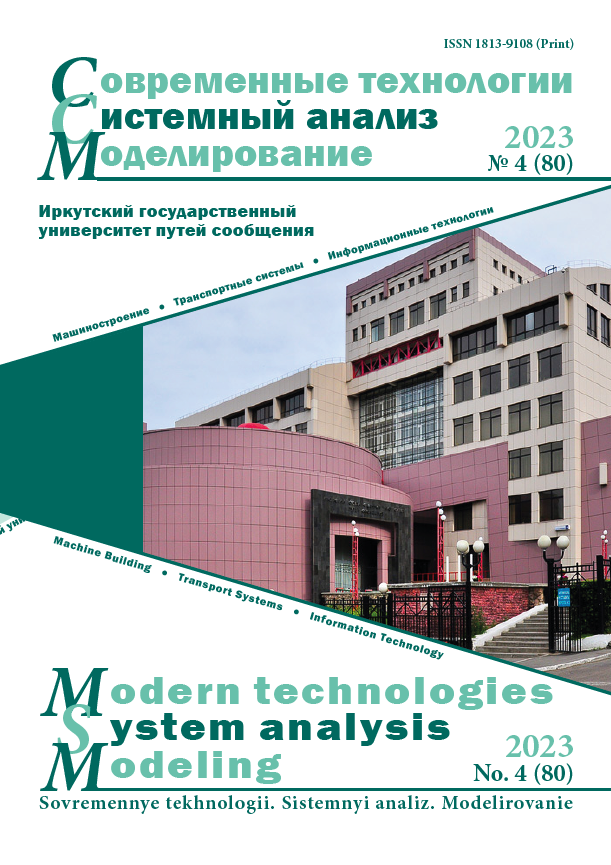Factor of technological precision in the algorithm of constructive evolution of the axle box unit of freight wagons
Keywords:
constructive evolution, modeling, resource, adaptation, axle box, precision, import substitutionAbstract
The tendency is considered of choosing a compositional solution according to the precision parameter when implementing a model into a workable device, which, in order to perform its main function, can acquire a new design solution, the whose level of perfection is determined by the assigned resource. As an adequate example, we used the axle box unit of a freight car, responsive to all loads and influences during the movement. The solution to the general problem is expected from not only the perspective of innovative technological support for production and repair, but also the creation of objectively more appropriate structural compositions with preferential localization of materials and parts, as well as maximizing import substitution. A preliminary generalization has been made in the evolution of the axle box unit of a freight wagon in connection with the development of precision in manufacturing processes whose basis currently being a roller bearing, which plays an adaptive role of transmitting vertical loads, and the presence of new structural materials as well as the availability of new structural materials, when the possibility of preventive rationalization appears, especially to increase the level of reliability and overall service life. The «isotropic» property of the material considered for use in the bearing design is confirmed, which, along with the declared parameters (low coefficient of friction ~ 0,02 and high hardness ~ 32 GPa), makes it possible to mitigate the level of precision requirements in manufacturing technology and the assignment of restrictions during the operation of the axle box unit in general. The article makes another attempt to develop the original position to present a technologically realistic applied aspect for the node optimization algorithm according to the criterion of precision, provided by the current state of science and production. Critically important in the composition of the axle box unit is the friction unit, which is operated in a very wide range of impacts and loads. An evolutionary structural composition based on a new antifriction material (AlMgB14) in the «sliding bearing» design scheme is evaluated using possible comparative calculations in a computer program such as ANSYS and with an assigned optimization criterion. It is shown that solving the problem within the framework of a technological algorithm with step-by-step optimization of the influence on the process of evolution of a structural solution of a heavily loaded freight car unit transmitting a wide range of influences is technically and mathematically feasible and, after specialized experimental confirmation, is available for industry use.
References
Калетин C.В., Гончаров С.Г., Конецкий А.К. Переход на кассету: в поисках оптимального решения // Вестн. ин-та проблем естественных монополий: техника железных дорог. 2019. № 4 (48). С. 6–9.
Тюньков В.В., Бузунова В.С., Пашков А.Е. Технологический алгоритм в перспективном конструктивном развитии железнодорожных грузовых вагонов колеи 1520 мм // Молодая наука Сибири. 2020. № 4 (10). С. 18–26. URL https://mnv.irgups.ru/sites/default/files/articles_pdf_files/tyunkov.pdf (дата обращения 18.06.2023).
Ванг П.Ф., Тогай М. Анализ нечеткой чувствительности и метод синтеза // Нечеткие множества и теория возможностей. Последние достижения : сб. ст. М. : Радио и связь, 1986. С. 377–390.
Галахов М.А., Гусятников П.Б., Новиков А.П. Математические модели контактной гидродинамики. М. : Наука, 1985. 294 с.
Задорожная Е.А., Караваев В.Г. Оценка теплового состояния сложнонагруженного подшипника с учетом реологических свойств смазочного материала // Двигатели внутреннего сгорания. 2012. № 2. С. 66–73.
Современная трибология: итоги и перспективы / Э.Д. Браун, И.А. Буяновский, Н.А. Воронин и др. М. : ЛКИ, 2008. 480 с.
Капица П.Л. Гидродинамическая теория смазки при качении // Журнал технической физики. 1955. Т. 25. № 4. С. 747–762.
Каплун А.Б., Морозов Е.М., Олферьева М.А. ANSYS в руках инженера. М. : Едиториал УРСС, 2003. 272 с.
Механика контактных взаимодействий / С.М. Майзикович, В.М. Александров, И.И. Аргатов и др. М. : Физматлит, 2001. 670 с.
A numerical approach for the analysis of deformable journal bearings / D. Denasciutti, M. Gallina, M. Gh. Munteanu et al. // Frattura ed Integrit Strutturale. 2012. Vol. 21. P. 37–45. DOI: 10.3221/IGF-ESIS.21.05.
Чигаев А.В., Кравчук А.С., Смалюк А.Ф. ANSYS для инженеров. М. : Машиностроение-1, 2004. 511 с.
Bair S.S. High-Pressure Rheology for quantitative elastohydrodynamics. Amsterdam : Elsiver, 2007. 250 p.
Bissett E.J., Spence D.A. The Line Contact Problem of Elastohydrodynamic Lubrication. II: Numerical Solutions of the In-tegrodifferential Equations in the Transition and Exit Layers // Proceedings of the Royal Society of London. Series A. Mathematical and Physical Sciences. 1989. Vol. 424. № 1867. P. 409–429.
Fortier A.E. Numerical Simulation of Hydrodynamic Bearings with Engineered Slip/No-Slip Surfaces. Atlanta : Georgia Insti-tute of Technology, 2004. 90 p.
Fortier A. E. Numerical Simulation of a Slider Bearing with an Engineered Slip/No-Slip Surface and Lubrication Engineering // 14th International Colloquium Tribology. Esslingen am Neckar, 2004. P. 1699–1704.
Пат. № 2697146 Рос. Федерация. Способ получения супертвердого керамического порошкового материала AlMgB14 / О.К. Лепакова, Б.Ш. Браверман, Н.И. Афанасьев и др. № 2018138211 ; заявл. 29.10.2018 ; опубл. 12.08.2019, Бюл. № 23. 9 с.
Супертвердый керамический порошковый материал алюмомагниевый борид AlMgB14 («скользкая керамика») // ТНЦ СО РАН : сайт. URL: http://www.tsc.ru/ru/razrabotki/ceramic.html (Дата обращения 28.09.2023).
Иванов В.А. Математическое моделирование упруго-гидродинамического взаимодействия тел в узлах трения : дис. … канд. техн. наук. Красноярск, 2018. 138 с.
Ландау Л.Д., Лифшиц Е.М. Теоретическая физика (в 10 т). Т. 7. Теория упругости. М. : Наука, 1987. 248 с.
Hamrock B.J., Schmid S.R., Jacobson B.O. Fundamentals of fluid film lubrication. New York, Basel : Marcel Dekker, Inc., 2004. 703 p.
Автоматическое формирование сетки треугольных элементов для произвольных плоских областей / А.С. Цыбенко, Н.Г. Ващенко, Н.Г Крищук и др. // Проблемы прочности. 1980. № 12. С. 84–87.
Зенкевич О. Метод конечных элементов в технике. М. : Мир, 1975. 541 с.


